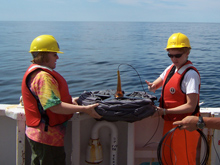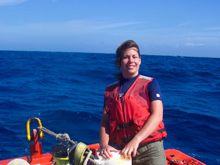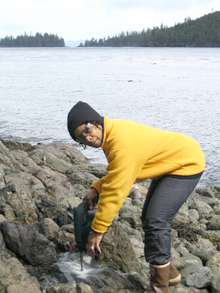NOAA's Teacher at Sea Program: Past, Present, and Future
Since 1990, NOAA’s Teacher at Sea program, managed by NOAA’s Office of Marine and Aviation Operations, has enabled qualified teachers from kindergarten through college to go to sea aboard NOAA research and survey vessels and work side-by-side with scientists, officers, and crew. By gaining such rich, first-hand experience, teachers can then incorporate their new knowledge into classroom curricula, while passing along their enthusiasm and kindling their students’ interest in science.
“On the final morning of the cruise, my eyes met a resplendent sunrise that shot stars across the shimmering waters of an endless sea. As we headed to the east, I grew quiet within… the bow of the ship seemed to leave traces of beautiful pigments on the sky’s canvas, an eternal embrace between the first ember of light and a lucid sky. Land is but hours away, but the memories of this journey will never leave my mind.”

Thomas Nassif, an elementary school teacher from Washington, DC, was on board NOAA ship Nancy Foster for 10 days in July while scientists conducted a lionfish survey off the coast of North Carolina.
This sentiment, captured by teacher Thomas Nassif on the last day of his research cruise in July 2005 aboard NOAA ship Nancy Foster, embodies much of the feedback the NOAA Teacher at Sea program receives from the teachers it sends out to sea to work on NOAA vessels. To some, it may be a surprise to hear that a research cruise could be a life-changing event. But for many NOAA Teachers at Sea, that is exactly how they describe their time working aboard a NOAA research vessel.
The Past
NOAA’s Teacher at Sea program began as what could best be described as a project in 1990, when NOAA Corps officer Lieutenant Ilene Byron thought it would be a great idea to take a teacher along on a research cruise. She chose a teacher from her ship’s homeport in Seattle, Washington. Apparently, the experience went so well, it became a yearly endeavor to bring teachers out on research missions on NOAA vessels.

NOAA's ship fleet provides hydrographic survey, oceanographic and atmospheric research, and fisheries research vessels to help NOAA understand and predict changes in the Earth's environment and wisely manage coastal and marine resources. The NOAA ship fleet currently consists of 19 active ships—including the Fairweather, pictured above. NOAA ships can be found in waters on the East and West coasts, the Gulf of Mexico, Alaska, and Hawaii.
Eventually, in 2004, this yearly “project” of taking teachers along on research cruises became a full-fledged program when NOAA’s Office of Marine and Aviation Operations, which houses and manages the program, hired a full-time program manager. Having witnessed the benefits of teachers working on vessel research missions to all those involved—the crews, the teachers, and the students—the Office of Marine and Aviation Operations realized that by making this project an official program with full-time management and funding, it could broaden its base of teachers and offer the opportunity of going to sea to teachers around the country.
Since the start of the program, some teachers have even come from other countries to participate in the program (the program accepts teachers from around the world). To date, nearly 500 kindergarten- through college-level teachers have had the opportunity to gain first-hand experience doing science at sea.
The Present
NOAA’s Teacher at Sea program has been able to send an average of 30 teachers out to sea each year. The official mission of NOAA’s Teacher at Sea program is to give teachers a clearer insight into our ocean planet and a greater understanding of maritime work and studies, thereby fostering an interdisciplinary educational experience that provides a unique environment for learning and teaching.

Teacher at Sea Joan Raybourn, from the Greenbrier Intermediate School in Chesapeake, Virginia, helped to deploy a drifter buoy while crossing the shoal area of Georges Bank, off the coast of Maine. Mrs. Raybourn’s students were able to track movement of the buoy as part of the NOAA Adopt-a-Drifter Program. Click image for larger view.
By participating in this program, it becomes possible for teachers to enrich their classroom curricula with a depth of understanding made possible by living and working side-by-side, day and night, with those who contribute to the world’s body of scientific knowledge.
The benefits of the Teacher at Sea program to NOAA have been substantial. To begin with, scientists, NOAA Corps officers, and crew gain motivated volunteers to help carry out their projects. Also, all onboard enjoy hosting someone who is enthusiastic and eager to learn about all aspects of the cruise.
Another crucial benefit to NOAA offered by the Teacher at Sea program is students’ increased exposure to knowledge of marine careers. By talking about their experiences and sharing photos or video taken during a cruise, teachers can encourage their students to consider potential marine careers with NOAA or other science-based organizations.
“NOAA’s Teacher at Sea program continues to be an effective way to introduce teachers to NOAA science in an up-close and personal way that helps [teachers] bring science alive for their students,” said Rear Admiral Samuel P. De Bow, Jr., director of NOAA’s Office of Marine and Aviation Operations. “The program has been so successful, we’re expanding it to make sure more teachers have an opportunity to participate and improve their research skills. It benefits NOAA as well. Enthusiastic teachers make great assistants and tend to boost the morale of everyone on board. After spending a couple of weeks on a ship, they also are able to offer career information to their students about the various shipboard jobs. We are always looking for good NOAA recruits! All around, it’s a win-win situation,” he said.

Melissa Fye, an elementary school teacher from Virginia, was aboard NOAA ship Hi'ialakai for 20 days in April 2005 while scientists conducted coral reef research. Click image for larger view.
And perhaps most importantly, the program promotes among teachers and their students a greater awareness of the need to understand and protect the world’s oceans and their resources.
Indeed, the benefits of the Teacher at Sea program are captured best by Melissa Fye, an elementary school teacher from Virginia, who said: “By being a Teacher at Sea, I will be bringing back to the classroom enthusiasm for the application of science in the real world. I want my students to know that life is not a collection of things, but a collection of experiences. My underlying goal is to teach my students that learning should be a life-long adventure! And isn't that what this trip is really all about?”
The Future

Linda Armwood, a high school teacher from Virginia, was aboard the NOAA ship Fairweather for 10 days in April and May 2006, while scientists conducted hydrography surveys off the Alaskan coast. Armwood will be the featured teacher in the next Teacher at Sea children’s book (third book in the four-book series).
In the near future, NOAA’s Teacher at Sea program hopes to expand the program by offering teachers and their school districts support to sail during the school year. Currently, most teachers sail during their summer vacations. Those teachers who do receive permission to sail during the school year, however, must be supported 100 percent by their school districts.
In addition, NOAA’s Teacher in the Air program has become a spin-off of the NOAA Teacher at Sea program. Similar to the Teacher at Sea program, the aim of the Teacher in the Air program is for teachers to develop their knowledge by flying aboard NOAA research aircraft and then bring that knowledge back to their students. Currently, the Teacher in the Air program is in a pilot phase and being evaluated to see if it can grow into its own program.

NOAA Teacher in the Air, Jessica Schwarz, a middle school teacher from Hawaii, flew aboard NOAA's jet aircraft, "Gonzo," as the crew gathered data to better predict winter storms. Including Gonzo, NOAA's Aircraft Operations Center maintains and operates a fleet of 11 scientific research, reconnaissance, and surveillance aircraft that directly support the varied programs of NOAA, enabling scientists to precisely observe, measure, and chart the dynamics of our coasts, oceans, and atmosphere.
Considering the overwhelmingly positive feedback from teachers not only about their first-hand research experiences but also about the use of their newfound knowledge in their classrooms, the future looks bright for NOAA’s Teacher at Sea program. Indeed, NOAA foresees many more teachers being given the opportunity to participate in the program and experience their own life-changing excursions aboard NOAA research vessels.
